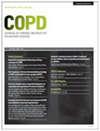Physiological Impairments on Respiratory Oscillometry and Future Exacerbations in Chronic Obstructive Pulmonary Disease Patients without a History of Frequent Exacerbations
IF 2.2
4区 医学
Q3 RESPIRATORY SYSTEM
COPD: Journal of Chronic Obstructive Pulmonary Disease
Pub Date : 2022-04-07
DOI:10.1080/15412555.2022.2051005
引用次数: 0
Abstract
Abstract Respiratory oscillometry allows measuring respiratory resistance and reactance during tidal breathing and may predict exacerbations in patients with chronic obstructive pulmonary disease (COPD). While the Global Initiative for Chronic Obstructive Lung Disease (GOLD) advocates the ABCD classification tool to determine therapeutic approach based on symptom and exacerbation history, we hypothesized that in addition to spirometry, respiratory oscillometry complemented the ABCD tool to identify patients with a high risk of exacerbations. This study enrolled male outpatients with stable COPD who were prospectively followed-up over 5 years after completing mMRC scale and COPD assessment test (CAT) questionnaires, post-bronchodilator spirometry and respiratory oscillometry to measure resistance, reactance, and resonant frequency (Fres), and emphysema quantitation on computed tomography. Total 134 patients were classified into the GOLD A, B, C, and D groups (n = 48, 71, 5, and 9) based on symptoms on mMRC and CAT and a history of exacerbations in the previous year. In univariable analysis, higher Fres was associated with an increased risk of exacerbation more strongly than other respiratory oscillometry indices. Fres was closely associated with forced expiratory volume in 1 sec (FEV1). In multivariable Cox-proportional hazard models of the GOLD A and B groups, either lower FEV1 group or higher Fres group was associated with a shorter time to the first exacerbation independent of the GOLD group (A vs B) and emphysema severity. Adding respiratory oscillometry to the ABCD tool may be useful for risk estimation of future exacerbations in COPD patients without frequent exacerbation history.无频繁发作史的慢性阻塞性肺疾病患者呼吸振荡测量的生理损伤和未来的加重
呼吸振荡法可以测量潮汐呼吸期间的呼吸阻力和电抗,并可预测慢性阻塞性肺疾病(COPD)患者的恶化情况。虽然全球慢性阻塞性肺疾病倡议(GOLD)提倡使用ABCD分类工具来根据症状和加重史确定治疗方法,但我们假设除了肺活量测定法外,呼吸振荡测定法还可以补充ABCD工具来识别高风险的加重患者。本研究招募了稳定型COPD男性门诊患者,在完成mMRC量表和COPD评估测试(CAT)问卷、支气管扩张剂后肺活量测定法和呼吸振荡测定法测量阻力、电抗和共振频率(Fres)以及计算机断层扫描肺气肿定量后,对他们进行了5年以上的前瞻性随访。根据mMRC和CAT的症状以及前一年的恶化史,总共134例患者被分为GOLD A、B、C和D组(n = 48、71、5和9)。在单变量分析中,与其他呼吸振荡指标相比,较高的Fres与加重风险增加的相关性更强。Fres与1秒用力呼气量(FEV1)密切相关。在GOLD A组和B组的多变量cox -比例风险模型中,较低FEV1组或较高FEV1组与较短的首次加重时间相关,独立于GOLD组(A vs B)和肺气肿严重程度。在ABCD工具中加入呼吸振荡测量可能对无频繁加重史的COPD患者未来加重的风险评估有用。
本文章由计算机程序翻译,如有差异,请以英文原文为准。
求助全文
约1分钟内获得全文
求助全文
来源期刊

COPD: Journal of Chronic Obstructive Pulmonary Disease
RESPIRATORY SYSTEM-
CiteScore
4.40
自引率
0.00%
发文量
38
审稿时长
6-12 weeks
期刊介绍:
From pathophysiology and cell biology to pharmacology and psychosocial impact, COPD: Journal Of Chronic Obstructive Pulmonary Disease publishes a wide range of original research, reviews, case studies, and conference proceedings to promote advances in the pathophysiology, diagnosis, management, and control of lung and airway disease and inflammation - providing a unique forum for the discussion, design, and evaluation of more efficient and effective strategies in patient care.
 求助内容:
求助内容: 应助结果提醒方式:
应助结果提醒方式:


